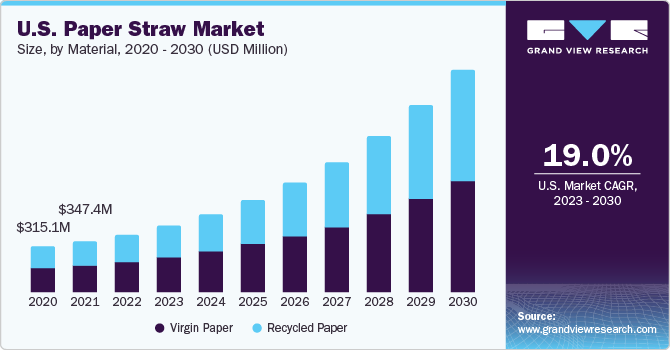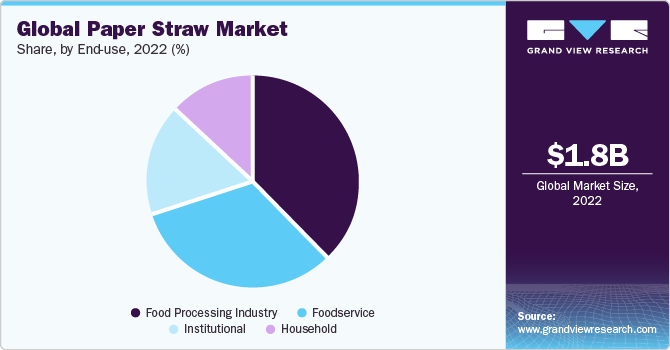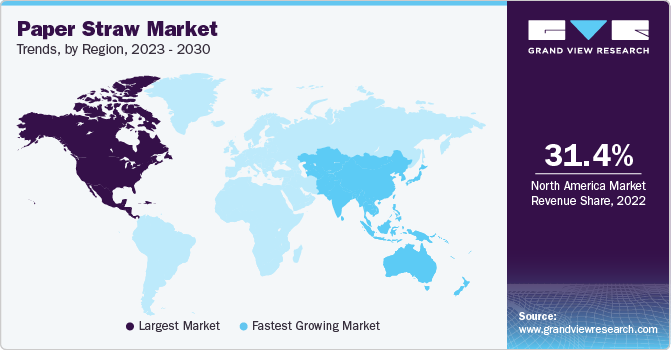- Home
- »
- Homecare & Decor
- »
-
Paper Straw Market Size, Share And Growth Report, 2030GVR Report cover
![Paper Straw Market Size, Share & Trends Report]()
Paper Straw Market Size, Share & Trends Analysis Report By Material (Virgin Paper, Recycled Paper), By Product Type (Non-Printed, Printed), By Straw Length, By Diameter, By Sales Channel, By End-use, By Region, And Segment Forecasts, 2023 - 2023
- Report ID: GVR-4-68040-155-2
- Number of Report Pages: 120
- Format: PDF, Horizon Databook
- Historical Range: 2018 - 2021
- Forecast Period: 2023 - 2030
- Industry: Consumer Goods
Paper Straw Market Size & Trends
The global paper straw market size was estimated at USD 1.80 billion in 2022 and is expected to grow at a compound annual growth rate (CAGR) of 20.8% from 2023 to 2030. The increasing awareness of plastic pollution, government regulations, the preference for sustainable packaging, growth in the foodservice industry, and consumer demand for eco-friendly alternatives are the key factors driving the market growth. As the global focus on sustainability intensifies, the market is expected to continue its growth over the forecast period. For instance, in October 2022, McDonald's Japan, a fast food chain, adopted paper straws and wooden utensils and phased out plastic material at approximately 2,900 locations across Japan. McDonald's already replaced plastic materials in the UK as a part of the strategic initiative to minimize the environmental impact of plastic waste and increase the use of renewable materials.

Growing awareness about the detrimental environmental impact of single-use plastic items, including plastic straws, has led to a shift in consumer preferences towards more sustainable alternatives. Paper straws have gained popularity as a viable eco-friendly option, as they are biodegradable, compostable, and renewable. H.B. Fuller Company conducted a survey in May 2021 to understand the consumer attitude toward paper straws. It reported that 65% of consumers supported the ban on single-use plastic straws; this sentiment can lead to an increased demand for alternative options, such as paper straws, as consumers actively seek out more sustainable choices.
The foodservice industry, including restaurants, cafes, and fast-food chains, is a significant consumer of single-use straws. According to the National Restaurant Association, the foodservice industry is expected to project USD 997 billion in 2023. With the increasing consumer demand for sustainable and eco-friendly practices, foodservice chains are transitioning to paper straws as an alternative to plastic. The industry's adoption of paper straws has significantly increased market growth.
Increasing government regulations on banning plastic materials in the foodservice and processing industry is expected to fuel the demand for paper straws. For instance, in China, violating the single-use plastic ban can be fined with a penalty between USD 1,400 and USD 14,200. Similarly, in India, under the 1986 Environment Protection Act, a lawbreaker could face a penalty of USD 1,249.6 or may be jailed. Such strict regulation by the government on significant industries would likely drive the market growth. Several leading FMCG companies, including Dabur ParleAgro, and other foodservice providers, including Starbucks, Coffee Company, McDonald's, and others, have already adopted paper straws at several locations.
The market has witnessed significant material innovation and a rise in the availability of different types and designs of paper straws. Manufacturers are producing paper straws that are durable, functional, and visually appealing to enhance the consumer experience. It has stimulated market growth by providing consumers with more options and encouraging wider adoption of paper straws. For instance, in July 2019, the UK-based Billerud Packaging collaborated with The Paper Straw Co. to launch the 180°U-Bend paper straw suitable for single drink cartoons. In addition, increasing efforts to enhance the overall performance of the material by the manufacturers also influence the demand for paper straws. In September 2021, H.B. Fuller Company introduced a new adhesive under its SwiftTak brand to meet the increasing demand for paper straws in India.
End-use Insights
Based on end-use, the market has been segmented into foodservice, institutional, household, and food processing industries. The food processing industry segment held the largest market share of 38.2% in 2022. The food processing industry produces a wide range of ready-to-drink materials such as juices, smoothies, iced coffees, and other beverages. These materials often require straws for convenient consumption. The increasing regulations and worldwide shift towards sustainable packaging increase the adoption of paper straws in this industry. For instance, in April 2019, the Coca‑Cola Company stopped distributing plastic drinking straws and stirrers in Australia. It replaced them with biodegradable and recycled paper straws accredited by the Forest Stewardship Council (FSC). Such factors are expected to drive the paper straw demand in the food processing industry.

The foodservice segment is expected to grow at the fastest CAGR of 23.2% over the forecast period. The growth of this industry has led to an increase in the number of outlets that serve beverages, which in turn has created a higher demand for straws. Changing consumer preferences and the impact of regulation influence this segment to adopt sustainable packaging materials, increasing the need for paper straws.
Regional Insights
North America dominated the market and held the largest market share of 31.4% in 2022. It can be attributed to the increasing availability of paper straws and the high impact of plastic regulations in American countries. Several cities and states in the U.S., including Charleston, New York City, South Carolina, Florida, and Miami Beach, have implemented bans or restrictions on single-use plastic items, including plastic straws, which have accelerated the adoption of paper straws as an alternative. The booming food and beverages industry and the changing consumer preference towards sustainable and plastic-free materials are fueling market dominance in the region.

Asia Pacific is expected to grow at the fastest CAGR of 22.9% over the forecast period. The growing population and increasing awareness about the detrimental effects of plastic waste on the environment are likely to drive the market growth. Increasing government regulations for single-use plastic bans in developed countries, including China and India, also contributed to this growth. Several companies in Japan have started producing and distributing paper straws, including Nippon Paper Industries Co., Ltd., TAKIGAWA CORPORATION, and others, to cater to the upcoming market demand.
Material Insights
Based on material, the virgin paper segment held the largest market share of 53.2% in 2022. It is attributed to the overall advantage the paper offers for developing paper straw, including better absorbency rate, excellent quality, and efficiency to withstand for a longer time. Such factors influence manufacturers to use virgin paper. In addition, virgin paper is safer, consisting of zero bacteria compared to recycled paper. According to a study by Laval University, it was discovered that the tested recycled paper had bacterial concentrations that were 100-1,000 times more than those of the virgin wood pulp. While the levels of bacteria found probably wouldn't have much of an impact on healthy people, they do present a risk to small children or those with compromised immune systems.
The recycled paper segment is expected to grow at the fastest CAGR of 21.9% over the coming years. As paper can be recycled four to five times, recycled paper is also thought of as the greenest alternative because it requires less energy and water. It emits fewer carbon emissions during the process than virgin paper does. This results in less waste going to landfills. The efforts to improve the quality of recycled paper and technological and manufacturing advancements are expected to drive the recycled paper used in paper straws over the forecast period.
Product Type Insights
Based on product type, the market is segmented into non-printed and printed. The non-printed segment held the largest market share of 57.4% in 2022. Non-printed paper straws offer several advantages that make them a desirable choice for environmentally conscious consumers and industries. The absence of ink or color pigments on the paper makes recycling easier and ensures that no additional chemicals or toxins are released during the decomposition process. Such factors were witnessed to drive the segment growth.
The printed segment is expected to grow at the fastest CAGR of 22.2% over the forecast period. It is attributed to the availability of printed straws in various colors, patterns, and branding elements, allowing end-users to create a unique and visually appealing experience for their customers. The innovation and development of printing technology and increasing consumer demand for aesthetics and patterns in paper straws would likely drive segment growth over the forecast period.
Straw Length Insights
Based on straw length, the 7.75-8.5 inches segment held the largest market share of 39.8% in 2022. This length range is commonly chosen for tall or large-sized beverages such as iced teas, cold coffees, smoothies, and oversized cups. The longer length allows the straw to reach the bottom of the container, ensuring a convenient and comfortable drinking experience. The growing demand for such beverages in the foodservice industry drives growth.
The <5.75 inches segment is expected to grow at the fastest CAGR of 22.8% over the forecast period. It is attributed to increased demand for small packaged drinks and the growing offering of such materials by several food and beverage manufacturers.
Diameter Insights
Based on diameter, the 0.196 - 0.25 inches segment held the largest market share of 35.3% in 2022. This diameter range is commonly used in every size of straw as it provides a better drinking experience and is suitable for every type of drink, including thick and regular.
The <0.15-inch diameter is expected to grow at the fastest CAGR of 22.7%. The growing use of standard drinks such as soda, water, and iced tea and cost-effectiveness are the key factors expected to fuel the growth of these straws.
Sales Channel Insights
Based on the sales channel, the market has been segmented into B2B and B2C. The B2B segment held the largest market share of 63.5% in 2022. Environmental concerns, government regulations, and corporate sustainability initiatives drive the B2B sales channel growth in the market. The foodservice and processing industries are the major buyers of paper straws from B2B sales channels. The large food processing industries such as FMCG and agro-food companies, including Mother Dairy Fruit & Vegetable PVT, Ltd., Amul, have removed integrated plastic straws from their small tetra packs of juice and milk and replaced them with paper straws. For instance, ParleAgro started incorporating paper straws in its popular brands, Frooti and Appy Fizz. These industries prefer to directly make bulk orders from the manufacturer of paper straws as it provides a cost-benefit compared to purchasing from B2C channels. Such factors drive the B2B segment growth.
The B2C segment is expected to grow at the fastest CAGR of 22.0% over the forecast period, owing to the growing awareness and concern about plastic pollution, which has led to increased consumer demand for sustainable packaging as an eco-friendly alternative, driving the growth of the B2C market. As per a report by Drapers shows, in January 2023 in the UK, consumer demand for sustainable packaging has increased to 81%.
Key Companies and Market Share Insights
The market features various players, which makes it a competitive market. The world's leading companies are using partnerships, collaborations, new material launches, and agreements as strategies to withstand the intense competition and increase their market share. For instance, in May 2022, SIG India launched various recyclable and sustainable paper straws in multiple dimensions and shapes. Paper from FSC-certified sources (license code: FSC C020428) was used to create SIG's paper straws. In keeping with India's plastic prohibition and as a viable remedy for the severe environmental harm that plastic straws cause, SIG introduced the new material. In addition, in August 2021, Novolex acquired Vegware Ltd. to enhance its paper material portfolio in sustainable brands and cater to the increasing demand for compostable foodservice packaging.
Key Paper Straw Companies:
- Hoffmaster Group, Inc.
- Huhtamaki Group
- BioPak
- Novolex
- Footprint
- Matrix pack
- strawland
- Jinhua Suyang Plastic Materialion Co., ltd.
- Tetra Laval Group
- Transcend Packaging
Paper Straw Market Report Scope
Report Attribute
Details
Market size value in 2023
USD 2.14 billion
Revenue forecast in 2030
USD 8.07 billion
Growth rate
CAGR of 20.8% from 2023 to 2030
Base year for estimation
2022
Historical data
2018 - 2021
Forecast period
2023 - 2030
Quantitative units
Revenue in USD million/billion, and CAGR from 2023 to 2030
Report coverage
Revenue forecast, company ranking, competitive landscape, growth factors, and trends
Segments covered
Material, product type, straw length, diameter, sales channel, end-use, region
Regional scope
North America; Europe; Asia Pacific; Central and South America; Middle East & Africa
Country scope
U.S.; Canada; Mexico; UK; France; Germany; China; India; Japan; Brazil; Saudi Arabia
Key companies profiled
Hoffmaster Group, Inc.; Huhtamaki Group; BioPak; Novolex; Footprint; Matrix pack; strawland; Jinhua Suyang Plastic Materialion Co. ltd.; Tetra Laval Group; Transcend Packaging
Customization scope
Free report customization (equivalent up to 8 analysts working days) with purchase. Addition or alteration to country, regional, and segment scope.
Pricing and purchase options
Avail customized purchase options to meet your exact research needs. Explore purchase options
Global Paper Straw Market Segmentation
This report forecasts revenue growth at global, regional, and country levels and provides an analysis of the latest industry trends in each of the sub-segments from 2018 to 2030. For this study, Grand View Research has segmented the global paper straw market report based on material, straw length, diameter, sales channel, end-use, and region:
-
Material Outlook (Revenue, USD Million, 2018 - 2030)
-
Virgin Paper
-
Recycled Paper
-
-
Product Type Outlook (Revenue, USD Million, 2018 - 2030)
-
Non-printed
-
Printed
-
-
Straw Length Outlook (Revenue, USD Million, 2018 - 2030)
-
<5.75 inches
-
5.75-7.75 Inches
-
7.75-8.5 Inches
-
8.5-10.5 Inches
-
>10.5 Inches
-
-
Diameter Outlook (Revenue, USD Million, 2018 - 2030)
-
<0.15 Inches
-
0.15 - 0.196 Inches
-
0.196 - 0.25 Inches
-
0.25 - 0.4 Inches
-
>0.4 Inches
-
-
Sales Channel Outlook (Revenue, USD Million, 2018 - 2030)
-
B2B
-
B2C
-
-
End-use Outlook (Revenue, USD Million, 2018 - 2030)
-
Foodservice
-
Institutional
-
Household
-
Food Processing Industry
-
-
Regional Outlook (Revenue, USD Million, 2018 - 2030)
-
North America
-
U.S.
-
Canada
-
Mexico
-
-
Europe
-
U.K
-
France
-
Germany
-
-
Asia Pacific
-
China
-
India
-
Japan
-
-
Central and South America
-
Brazil
-
-
Middle East and Africa
-
Saudi Arabia
-
-
Frequently Asked Questions About This Report
b. The global paper straw market size accounted for USD 1.80 billion in 2022 and is expected to reach USD 2.14 billion in 2023
b. The global paper straw market, in terms of revenue, is expected to grow at a compound annual growth rate of 20.8% from 2023 to 2030 to reach USD 8.07 billion by 2030
b. North America dominated the paper straw market with a revenue share of 31.4% in 2022. It can be attributed due to the implementation of stringent regulations on single use plastic in the U.S. and Canada and the increasing demand for sustainable products.
b. Some of the key players operating in the paper straw market include Hoffmaster Group, Inc., Huhtamaki Group, BioPak, Novolex, Footprint, Matrix pack, strawland, Jinhua Suyang Plastic Materialion Co., ltd., Tetra Laval Group, Transcend Packaging, among others
b. The key factors that are driving the global paper straw market is the increasing shift toward bio-based products to reduce the dependency on conventional plastic straws, the impact of regulations, and the rapid adoption of sustainable products worldwide
Share this report with your colleague or friend.
![gvr icn]()
NEED A CUSTOM REPORT?
We can customize every report - free of charge - including purchasing stand-alone sections or country-level reports, as well as offer affordable discounts for start-ups & universities. Contact us now
![Certified Icon]()
We are GDPR and CCPA compliant! Your transaction & personal information is safe and secure. For more details, please read our privacy policy.
We are committed towards customer satisfaction, and quality service.
"The quality of research they have done for us has been excellent."





